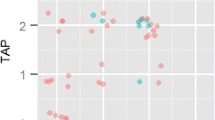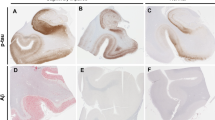Summary
Autopsied brains from 55 patients with dementia between 59–95 years of age (mean age 77.9±8.1 years) and 19 non-demented individuals between 46–91 years of age (mean age 74.3±10.5 years) were examined to establish histopathological criteria for normal ageing, primary degenerative [Alzheimer's disease (AD)/senile dementia of Alzheimer type (SDAT)] and vascular (multi-infarct) dementia (MID) disorders. Senile/neuritic plaques, neurofibrillary tangles, microscopic infarcts and perivascular serum protein deposits were quantified in the frontal lobe (Brodmann area 10) and in the hippocampus. The demented patients were classified according to the DSM-III criteria into AD/SDAT and MID. Operationally defined histopathological criteria for dementias, based on the degree/amount of the histopathological changes seen in aged non-demented patients, were postulated. The demented patients were clearly separable into three histopathological types, namely AD/SDAT, MID and AD-MID, the dementia type where both the degenerative and the vascular changes are coexistent in greater extent than are seen in the non-demented individuals. Using general clinical, gross neuroanatomical and histopathological data three separate dementia classes, namely AD/SDAT, MID and AD-MID, were visualized in two-dimensional space by multivariate data analysis. This analysis revealed that the pathology in the AD-MID patients was not merely a linear combination of the pathology in AD/SDAT and MID, indicating that AD-MID might represent a dementia type of its own. The clinical diagnosis for AD/SDAT and MID was certain in only half of the AD/SDAT and one third of the MID cases when evaluated histopathologically and by multivariate data analysis. AD/SDAT, MID and AD-MID were histopathologically diagnosed in 49%, 24% and 27%, respectively, of all the dementia cases studied. Opposite correlation between the number of tangles, plaques and the patient age in non-demented and AD/SDAT cases were observed, indicating that the pathogenesis of tangles and plaques in the two groups of patients might be different and that AD/SDAT might not be a form of an exaggerated ageing process.
Similar content being viewed by others
References
Alfuzoff I, Adolfsson R, Grundke-Iqbal I, Winblad B (1985) Perivascular deposits of serum proteins in cerebral cortex in vascular dementia. Acta Neuropathol (Berl) 66:292–298
Alafuzoff I, Adolfsson R, Grundke-Iqbal I, Winblad B (1987) Blood-brain barrier in Alzheimer dementia and in non-demented elderly: an immunoperoxidase study. Acta Neuropathol (Berl) 73:160–166
American Psychiatric Association (1980) Diagnostic and statistical manual of mental disorders. Organic dementia disorders, 3rd edn. APA, Washington DC, pp 101–161
Ball MJ (1976) Neurofibrillary tangles and the pathogenesis of dementia: a quantitative study. Neuropathol Appl Neurobiol 2:395–410
Blessed G, Tomlinson BE, Roth M (1968) The association between quantitative measures of dementia and the senile change in the cerebral grey matter of elderly subjects. Br J Psychiatry 114:797–811
Brun A, Englund E (1981) Regional pattern of degeneration in Alzheimer's disease: neuronal loss and histopathological grading. Histopathology 5:549–564
Corsellis JAN (1976) Aging and dementia. In: Blackwood W, Corsellis JAN (eds) Greefield's neuropathology. Arnold, London, pp 796–848
Dayan AD (1970a) Quantitative histological studies on the aged human brains. I. Senile plaques and neurofibrillary tangles in “normal” patients. Acta Neuropathol (Berl) 16:85–94
Dayan AD (1970b) Quantitative histological studies on the aged human brains. II. Senile plaques and neurofibrillary tangles in demented patients. Acta Neuropathol (Berl) 16:95–102
Reuck J de, Sieben G, de Coster W, vander Eecken H (1982) Dementia and confusional state in patients with cerebral infarcts. Eur Neurol 21:94–97
Fisher CM (1968) Dementia in cerebral vascular disease. In: Siekert RG, Whisnant JP (eds) Transac. 6th Conf. on Cerebral Vascular Diseases, Princeton, NJ. Grune and Stratton, New York, pp 232–236
Gibson PH (1983) Form and distribution of senile plaques seen in silver-impregnated sections in the brains of intellectually normal elderly people and people with Alzheimer-type dementia. Neuropathol App Neurobiol 9:379–389
Hachinski VC, Iliff LD, Zilhka E, DuBoulay GH, McAllister VL, Marshall J, Russel RWR, Symon L (1975) Cerebral blood flow in dementia. Arch Neurol 32:632–637
Matsuyama A, Nakumara S (1978) Senile changes in the brain in the Japanese. In: Katzman R, Terry RD, Bick K (eds) Alzheimer's disease. Raven Press, New York, pp 287–297
McKhann G, Dracham D, Folstein H, Katzman R, Price D, Stadlan EM (1984) Clinical diagnosis of Alzheimer's disease. Report of the NINCDS-ARDRA work group under the auspices of Department of Health and Human Services Task Forces on Alzheimers Disease. Neurology 34:939–944
Reisberg B, Ferris SH, deLeon HJ, Crook T (1982) The global deterioration scale (GDS) an instrument for assessment of primary degenerative dementia (PDD). Am J Psychiatry 139:1136–1139
Rosen WG, Terry RD, Fuld PA, Katzman R, Peck A (1980) Pathological verification of ischemic score in differentiation of dementias. Ann Neurol 7:486–488
Todorov AB, Go RCP, Constantinidis J, Elston RC (1975) Specificity of the clinical diagnosis of dementia. J Neurol Sci 26:81–98
Tomlinson BE (1980) The structural and quantitative aspects of the dementias. In: Roberts PJ (ed) Biochemistry of dementias. J Wiley & Sons, Chichester, pp 15–52
Tomlinson BE, Blessed G, Roth M (1968) Observation on the brains of non-demented old people. J Neurol Sci 7:331–356
Tomlinson BE, Blessed G, Roth M (1970) Observation on the brains of demented old people. J Neurol Sci 11:205–242
Ulrich J (1982) Senile plaques and neurofibrillary tangles of the Alzheimer type in non-demented individuals at presenile age. Gerontology 28:86–90
Wold S, Albano C, Dunn WJ III, Esbensen K, Hellberg S, Johansson E, Sjöström M (1983) Pattern recognition: finding and using regularities in multivariate data. In: Martens H, Russwurm H Jr (eds) Food research and data analysis. Applied Science, London New York, pp 1–36
Wold S, Albano C, Dunn WJ III, Edlung U, Esbensen K, Geladi P, Hellberg S, Johansson E, Lindberg W, Sjöström M (1984) Multivariate data analysis in chemistry. In: Kowalski BR (ed) Proceedings of the NATO Adv. Study Inst. on Chemometrics, Cosenza, Italy. Reidel, Dordrecht, pp 1–79
Wold S, Dunn WJ III, Hellberg S (1984) Pattern recognition as a tool for drug design. In: Drug design: fact or fantasy. Academic Press, London, pp 93–117
Author information
Authors and Affiliations
Rights and permissions
About this article
Cite this article
Alafuzoff, I., Iqbal, K., Friden, H. et al. Histopathological criteria for progressive dementia disorders: clinical-pathological correlation and classification by multivariate data analysis. Acta Neuropathol 74, 209–225 (1987). https://doi.org/10.1007/BF00688184
Received:
Accepted:
Issue Date:
DOI: https://doi.org/10.1007/BF00688184




